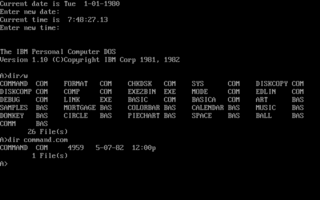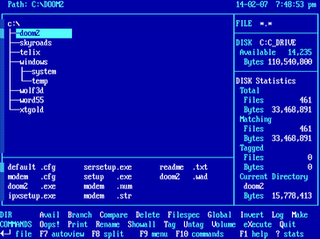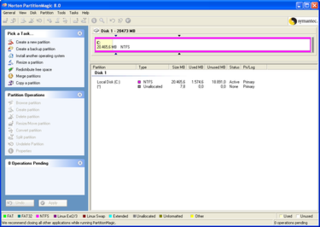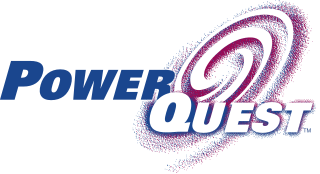Related Research Articles

IBM PC DOS, also known as PC DOS or IBM DOS, is a discontinued disk operating system for the IBM Personal Computer, its successors, and IBM PC compatibles. It was manufactured and sold by IBM from the early 1980s into the 2000s. Developed by Microsoft, it was also sold by that company as MS-DOS. Both operating systems were identical or almost identical until 1993, when IBM began selling PC DOS 6.1 with new features. The collective shorthand for PC DOS and MS-DOS was DOS, which is also the generic term for disk operating system, and is shared with dozens of disk operating systems called DOS.

XTree is a file manager program originally designed for use under DOS. It was published by Executive Systems, Inc. (ESI) and first released on 1 April 1985, and became highly popular. The program uses a character-mode interface, which has many elements typically associated with a graphical user interface.

PartitionMagic is a utility software program for hard disk drive partitioning originally made by PowerQuest, but subsequently owned by Symantec. As of December 8, 2009, the Symantec website stated that they no longer offer PartitionMagic.

PowerQuest was a software company that produced utility software. It was acquired by Symantec in 2003. PowerQuest's market focus was on management of computer data storage, especially file systems and disk partitions. Their products included PartitionMagic, DriveCopy, Drive Image, and ServerMagic.
GHOST, now called Symantec™ GHOST Solution Suite (GSS) for enterprise, is a disk cloning and backup tool originally developed by Murray Haszard in 1995 for Binary Research. The technology was bought in 1998 by Symantec.
Binary Research Ltd was a company founded in Auckland, New Zealand by Murray Haszard in 1991 after the sale of his previous company, B32 Software.

Norton Commander (NC) is a discontinued prototypical orthodox file manager (OFM), written by John Socha and released by Peter Norton Computing. NC provides a text-based user interface for managing files on top of MS-DOS. It was officially produced between 1986 and 1998. The last MS-DOS version of Norton Commander, 5.51, was released on July 1, 1998.
Norton AntiVirus is an anti-virus or anti-malware software product founded by Peter Norton, developed and distributed by Symantec since 1990 as part of its Norton family of computer security products. It uses signatures and heuristics to identify viruses. Other features included in it are e-mail spam filtering and phishing protection.

Norton Utilities is a utility software suite designed to help analyze, configure, optimize and maintain a computer. The latest version of the original series of Norton Utilities is Norton Utilities 16 for Windows XP/Vista/7/8, released 26 October 2012.

Microsoft Anti-Virus (MSAV) is an antivirus program introduced by Microsoft for its MS-DOS operating system. The program first appeared in MS-DOS version 6.0 (1993) and last appeared in MS-DOS 6.22. The first version of the antivirus program was basic, had no inbuilt update facility and could scan for 1,234 different viruses. Microsoft Anti-Virus for Windows (MWAV), included as part of the package, was a front end that allowed MSAV to run properly on Windows 3.1x.
Norton GoBack is a disk utility for Microsoft Windows that can record up to 8 GB of disk changes. When the filesystem is idle for a few seconds, it marks these as "safe points". The product allows the disk drive to be restored to any point within the available history. It also allows older versions of files to be restored, and previous versions of the whole disk to be browsed. Depending on disk activity, the typical history might cover a few hours to a few days.

PC Tools is a collection of software utilities for DOS developed by Central Point Software.

Norton SystemWorks is a discontinued utility software suite by Symantec Corp. It integrates three of Symantec's most popular products – Norton Utilities, Norton CrashGuard and Norton AntiVirus – into one program designed to simplify solving common PC issues. Backup software was added later to high-end editions. SystemWorks was innovative in that it combined several applications into an all-in-one software for managing computer health, thus saving significant costs and time often spent on using different unrelated programs. SystemWorks, which was introduced in 1998 has since inspired a host of competitors such as iolo System Mechanic, McAfee Nuts And Bolts, Badosoft First Aid and many others.
The Logical Disk Manager (LDM) is an implementation of a logical volume manager for Microsoft Windows NT, developed by Microsoft and Veritas Software. It was introduced with the Windows 2000 operating system, and is supported in Windows XP, Windows Server 2003, Windows Vista, Windows 7, Windows 8, Windows 10 and Windows 11. The MMC-based Disk Management snap-in hosts the Logical Disk Manager. On Windows 8 and Windows Server 2012, Microsoft deprecated LDM in favor of Storage Spaces.
A volume boot record (VBR) is a type of boot sector introduced by the IBM Personal Computer. It may be found on a partitioned data storage device, such as a hard disk, or an unpartitioned device, such as a floppy disk, and contains machine code for bootstrapping programs stored in other parts of the device. On non-partitioned storage devices, it is the first sector of the device. On partitioned devices, it is the first sector of an individual partition on the device, with the first sector of the entire device being a Master Boot Record (MBR) containing the partition table.

Microsoft Drive Optimizer is a utility in Microsoft Windows designed to increase data access speed by rearranging files stored on a disk to occupy contiguous storage locations, a technique called defragmentation. Microsoft Drive Optimizer was first officially shipped with Windows XP.
VHD and its successor VHDX are file formats representing a virtual hard disk drive (HDD). They may contain what is found on a physical HDD, such as disk partitions and a file system, which in turn can contain files and folders. They are typically used as the hard disk of a virtual machine, are built into modern versions of Windows, and are the native file format for Microsoft's hypervisor, Hyper-V.
Disk cloning software facilitates a disk cloning operation by using software techniques to copy data from a source to a destination drive or to a disk image.

MS-DOS is an operating system for x86-based personal computers mostly developed by Microsoft. Collectively, MS-DOS, its rebranding as IBM PC DOS, and a few operating systems attempting to be compatible with MS-DOS, are sometimes referred to as "DOS". MS-DOS was the main operating system for IBM PC compatibles during the 1980s, from which point it was gradually superseded by operating systems offering a graphical user interface (GUI), in various generations of the graphical Microsoft Windows operating system.
A master boot record (MBR) is a type of boot sector in the first block of partitioned computer mass storage devices like fixed disks or removable drives intended for use with IBM PC-compatible systems and beyond. The concept of MBRs was publicly introduced in 1983 with PC DOS 2.0.
References
- 1 2 "PowerQuest Expands Drive Image for Retail Markets". Powerquest. July 28, 1997. Archived from the original on January 15, 1998.
PowerQuest Corporation announces PowerQuest Drive Image for the retail market, scheduled for release September 1997
- 1 2 Bisceglia, Roberto. "La clonazione dei dischi - Powerquest Drive Image 3.0 pro". docenti.org (in Italian). Archived from the original on July 17, 2014.
Le metodologie operative sono molto simili a quelle di Imageblaster: entrambi i programmi lavorano in ambiente DOS, hanno un wizard per la creazione dei dischi, dispongono di un editor di immagini in ambiente Windows...Si può così procedere alla creazione dell'immagine. La prima schermata (ricordo che il programma è in DOS, anche se le immagini che seguono sembrano tipiche di Windows)...(Screen capture of DOS version begin)
- ↑ storagecraft.com
ТСюя